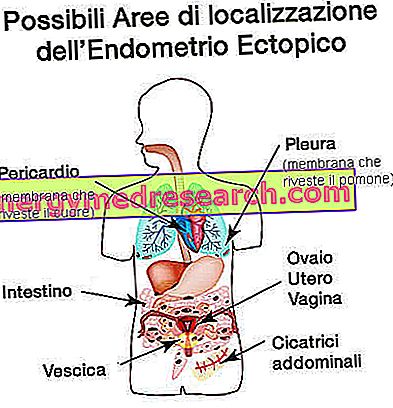Generality
Endometriosis, or endometriotic disease, is a condition characterized by the presence of endometrial tissue in sites where the latter normally should not be present, ie outside the uterus.
This tissue, therefore, is called ectopic endometrium.

Typical of women of childbearing age, endometriotic disease is one of the most common causative factors of chronic pelvic pain in women of childbearing age.
Despite the great clinical interest that endometriosis arouses, especially in recent years, this disease still remains largely unknown, especially as regards its consequences on fertility.
Insights on Endometriosis
What is endometrium? What is endometriosis? CauseSymptomsComplications DiagnosisTherapyPrognosisPreventionTake the Test and find out if you suffer from entometriosis
What is the endometrium
Preceded in order by the perimeter and by the myometrium, the endometrium, or endometrial tissue, is the mucous membrane of the uterus and represents the innermost cellular layer of the latter.

The so-called epithelium of covering, formed by a single layer of ciliated columnar cells (the most intimate portion), and the so-called lamina propria or stroma, composed of highly vascularized and rich muciparous connective tissue (portion bordering on the myometrium).
Due to the influence of estrogen and progesterone, secreted by the ovaries during the menstrual cycle, the endometrium is renewed regularly and this guarantees the constant presence of an environment suitable for the implantation of an embryo.
What is endometriosis?
Endometriosis, or endometriotic disease, is a disease of women, characterized by the presence of endometrium where this is not normally present, therefore outside the uterus or in inappropriate parts of the uterus.
In medicine, the endometrium located where it should not exist is called ectopic endometrium or ectopic endometrial tissue .
Endometriosis is a chronic condition, ie long-term.
Internal endometriosis and external endometriosis
Experts in the field of female genital tract diseases distinguish endometriosis in:
- internal endometriosis, when the ectopic endometrium is located in the thickness of the myometrium;
- external endometriosis, when the ectopic endometrium is located
- inside the pelvis (ex: in the ovaries, between the rectum and the uterus, between the rectum and the vagina, in the fallopian tubes, in the bladder, in the ureter and / or in the sigma portion of the colon)
- or outside the pelvis (ex: on the navel, on the vagina, on the vulva, on the abdomen, on the appendix, on the kidneys and / or on the lungs).

Between internal endometriosis and external endometriosis, the most common form of endometriotic disease is external endometriosis, in this case the external endometriosis affecting the ovaries.
| Endometriosis | |
| Internal endometriosis (or adenomyosis) | When the ectopic endometrium has "infested" the myometrium. |
| External endometriosis (or proper endometriosis) | When the ectopic endometrium has invaded the pelvic organs (eg: fallopian tubes, ovaries, rectum, bladder etc.) or anatomical structures outside the pelvis (eg: vagina, vulva, lungs, kidneys, navel, etc.). |
Curiosity: does male endometriosis exist?
Recently, some studies have described the presence of endometrial tissue also in men, to be precise in the prostate .
According to the experts, this presence would be the embryonic residue of sketches of genitals, whose development was interrupted very early.
Epidemiology
Endometriosis can affect women of any age; however, it proves to have a particular predilection for female subjects of childbearing age between 30 and 40 years.
The incidence of endometriosis is quite high: according to the most reliable statistical research, in fact, the number of women suffering from endometriotic disease would represent 6-10% of the general female population.
Based on data on the prevalence of endometriosis, the latter is decidedly more common in infertile women with chronic pelvic pain.
In Italy, women with endometriosis are more than 3 million ; in the European Union, about 14 million; in the world, finally, about 150, 000, 000.
Causes
The precise causes of endometriosis are unclear. However, there are several theories that try to explain how endometriotic disease can arise:
- Theory of retrograde menstruation . According to this theory, clusters of endometrial cells, which fall apart during menstruation, would flow back through the fallopian tubes to the abdominal-pelvic cavity, where they would be implanted on the peritoneum and the organs wrapped by the peritoneum. The implantation of the aforementioned cells within the abdominal-pelvic cavity gives rise to the phenomenon of the so-called "endometriotic islands".
To support this hypothesis is the fact that the most frequent sites of endometriosis are the fallopian tubes, the ovaries and the Douglas excavation (that is, the hollow created by the space between the posterior part of the uterus and the anterior part of the rectum ), all anatomical elements of the abdominal-pelvic compartment.
- Metaplastic theory . According to the metaplastic theory, peritoneum cells would undergo, for unknown reasons, a transformation into endometrial cells.
If true, the metaplastic theory would explain the exceptional formation of endometrial tissue in the bladder and prostate of male subjects.
- Dissemination theory for lymphatic and blood . According to this theory, endometrial cells could reach other organs (eg: lungs or kidneys), through the lymphatic system or blood (via the pelvic veins).
The theory of dissemination by lymphatic and hematic is the most accepted hypothesis, to explain all the presence of endometrium outside the pelvic cavity and which cannot depend on retrograde transport.
- Theory of the iatrogenic plant . This theory is the result of the demonstration that there is a possibility of implantation of endometrial tissue on surgical scars, following cesarean section or operations to remove the uterus (hysterectomy).
- Theory of endoperitoneal immune alteration . Normally, the immune system recognizes the foreign cells of the endometrium that have flowed back into the abdominal cavity, at the time of menstruation, and eliminates them.
According to the theory of endoperitoneal immune alteration, an anomaly of the aforementioned immune mechanism, induced by a genetic mutation, would allow some endometrial cells to survive and multiply.
- Hormonal theory . This theory states that, in some subjects, endometriosis would depend on the activity of estrogens, which - during female puberty - would induce transformation of some cells into endometrial cells, originally destined to become something else.
This theory has raised a debate about oral contraceptives with low estrogen content and high progesterone content: the topic of discussion is whether or not such drugs can have a protective effect against endometriosis.
Risk factors
According to experts, they are endometriosis risk factors:
- Absence of pregnancies. In other words, women who have never been pregnant are more at risk than women who have become pregnant at least once in their life;
- Menarche (ie the first menstruation) at an early age;
- Menopause at a very old age;
- Short menstrual cycles (for example, duration less than 27 days);
- High levels of estrogen in the body or exposure to estrogen which adds to the amount of estrogen normally produced by the body;
- Large consumption of alcohol;
- Family history of endometriosis;
- The presence of any medical condition that prevents the normal passage of menstrual flow outside the body;
- The presence of uterine anomalies.



